demo课少儿英语
- 格式:ppt
- 大小:2.68 MB
- 文档页数:17
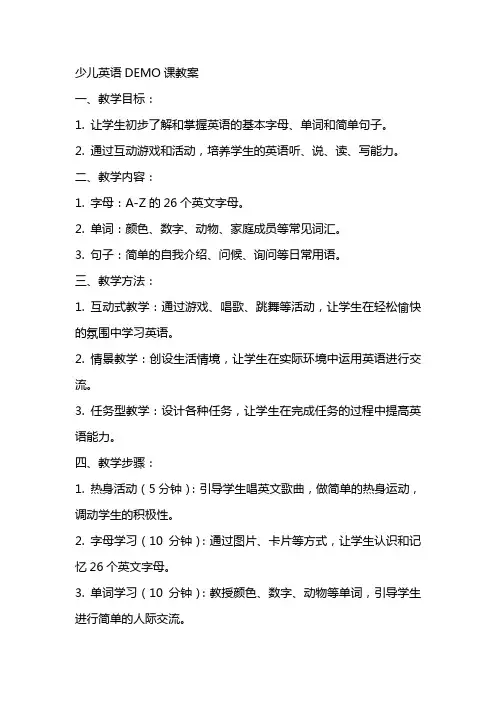
少儿英语DEMO课教案一、教学目标:1. 让学生初步了解和掌握英语的基本字母、单词和简单句子。
2. 通过互动游戏和活动,培养学生的英语听、说、读、写能力。
二、教学内容:1. 字母:A-Z的26个英文字母。
2. 单词:颜色、数字、动物、家庭成员等常见词汇。
3. 句子:简单的自我介绍、问候、询问等日常用语。
三、教学方法:1. 互动式教学:通过游戏、唱歌、跳舞等活动,让学生在轻松愉快的氛围中学习英语。
2. 情景教学:创设生活情境,让学生在实际环境中运用英语进行交流。
3. 任务型教学:设计各种任务,让学生在完成任务的过程中提高英语能力。
四、教学步骤:1. 热身活动(5分钟):引导学生唱英文歌曲,做简单的热身运动,调动学生的积极性。
2. 字母学习(10分钟):通过图片、卡片等方式,让学生认识和记忆26个英文字母。
3. 单词学习(10分钟):教授颜色、数字、动物等单词,引导学生进行简单的人际交流。
4. 句子学习(5分钟):学习简单的自我介绍、问候、询问等日常用语,让学生进行角色扮演。
5. 互动游戏(10分钟):设计有趣的英语游戏,让学生在游戏中运用所学知识。
6. 总结与作业(5分钟):回顾本节课所学内容,布置适当的作业,巩固所学知识。
五、教学评价:1. 观察学生在课堂上的参与程度,了解学生的学习兴趣。
2. 评估学生在角色扮演、游戏等活动中的表现,检验学生的英语实际运用能力。
3. 收集学生作业,检查学生的学习效果。
六、教学资源:1. 字母卡片:26张英文字母卡片。
2. 单词卡片:颜色、数字、动物等单词卡片。
3. 教学挂图:家庭成员、简单日常用品等图片。
4. 录音机、音响等音响设备。
5. 教学PPT:包含字母、单词、句子等教学内容。
七、教学环境:1. 教室布置:挂上色彩鲜艳的英语海报,营造轻松愉快的氛围。
2. 座位安排:学生围成圆圈或排成两队,便于互动和活动。
3. 教学用具:确保每名学生有一套字母卡片和单词卡片。
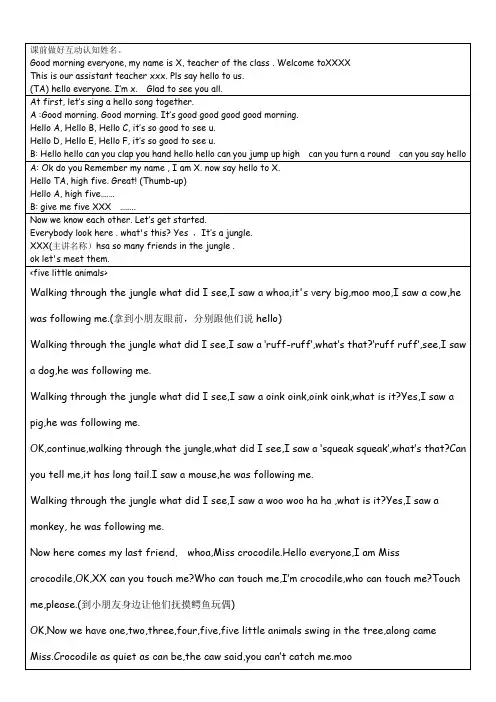
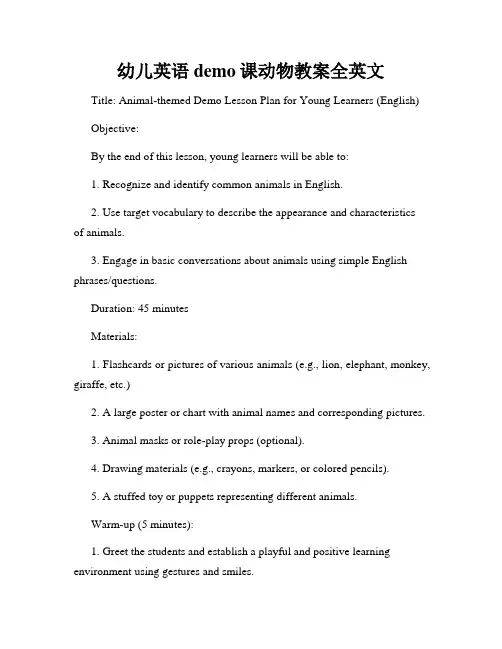
幼儿英语demo课动物教案全英文Title: Animal-themed Demo Lesson Plan for Young Learners (English)Objective:By the end of this lesson, young learners will be able to:1. Recognize and identify common animals in English.2. Use target vocabulary to describe the appearance and characteristicsof animals.3. Engage in basic conversations about animals using simple English phrases/questions.Duration: 45 minutesMaterials:1. Flashcards or pictures of various animals (e.g., lion, elephant, monkey, giraffe, etc.)2. A large poster or chart with animal names and corresponding pictures.3. Animal masks or role-play props (optional).4. Drawing materials (e.g., crayons, markers, or colored pencils).5. A stuffed toy or puppets representing different animals.Warm-up (5 minutes):1. Greet the students and establish a playful and positive learning environment using gestures and smiles.2. Sing a popular children's song about animals, such as "Old MacDonald Had a Farm," to pre-introduce the topic. Encourage the children to sing along and make animal sounds.Introduction (10 minutes):1. Present the flashcards/pictures of different animals.2. Elicit the names of the animals from the students and repeat the words together.3. Use the poster or chart to show the names of each animal, pointing to the corresponding picture as you say the word.4. Distribute animal masks or props for the students to wear or hold, creating a fun and engaging atmosphere.Vocabulary and Language Practice (15 minutes):1. Hold up one of the flashcards or pictures and ask the students, "What animal is this?"2. Once they respond, provide the correct answer and model the pronunciation.3. Show the picture to the class again and ask questions like, "What sound does it make?" or "What color is it?"4. Encourage the students to repeat the questions and answers, both individually and as a group.5. Use the stuffed toy or puppets to act out a brief conversation between animals, modeling simple English phrases and questions for the students to imitate.Activity (15 minutes):1. Divide the students into pairs or small groups.2. Distribute drawing materials and assign each group an animal.3. Instruct the students to take turns describing and drawing their assigned animal, using the target vocabulary and phrases they have learned.4. Circulate among the groups, offering assistance and feedback as needed.5. After a designated time, invite each group to present their drawings and descriptions to the class.Closure (5 minutes):1. Review the names of the animals, using the flashcards or pictures.2. Encourage the students to recap what they have learned about their assigned animal during the activity.3. Sing the animal song from the warm-up activity again, allowing the students to actively participate and demonstrate their knowledge.Extension Activity (optional):1. Provide coloring worksheets with different animal images.2. Instruct the students to color the animals and label them with the corresponding name in English.3. Display the completed worksheets on the classroom walls for further reinforcement and visual reference.Notes:- Adapt the level of difficulty and complexity based on the age and language proficiency of the students.- Use gestures, visuals, and actions to support comprehension throughout the lesson.- Encourage active participation from all students by incorporating opportunities for speaking, listening, and creative expression.- Provide continuous positive reinforcement and create an inclusive and supportive learning environment.。

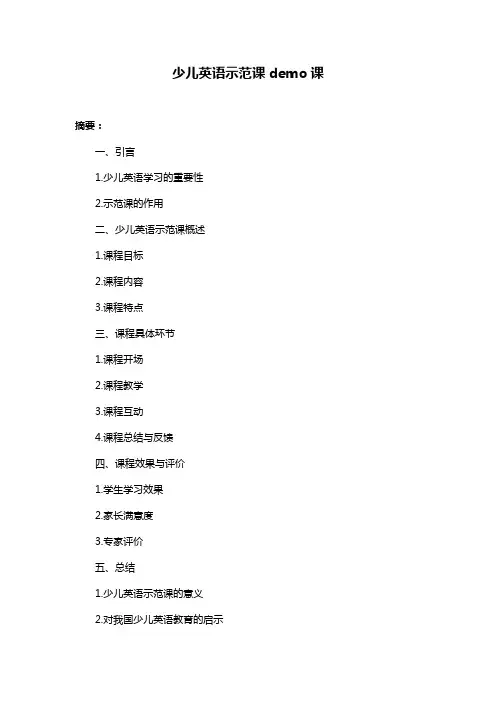
少儿英语示范课demo课摘要:一、引言1.少儿英语学习的重要性2.示范课的作用二、少儿英语示范课概述1.课程目标2.课程内容3.课程特点三、课程具体环节1.课程开场2.课程教学3.课程互动4.课程总结与反馈四、课程效果与评价1.学生学习效果2.家长满意度3.专家评价五、总结1.少儿英语示范课的意义2.对我国少儿英语教育的启示正文:一、引言随着全球化的加速推进,英语作为国际通用语言,在我国受到了前所未有的重视。
特别是对于少儿阶段,英语学习不仅能提高孩子们的综合素质,还能为他们日后的发展打下坚实基础。
为了更好地推广少儿英语教育,许多学校和教育机构纷纷开设了少儿英语示范课,以展示英语教学的魅力和效果。
二、少儿英语示范课概述1.课程目标:少儿英语示范课旨在激发孩子们对英语的兴趣,培养他们良好的英语学习习惯,提高听说读写综合能力。
2.课程内容:课程内容涵盖了英语基础知识、简单日常对话、英语儿歌、英语故事等方面,旨在让孩子们在轻松愉快的氛围中学习英语。
3.课程特点:示范课注重培养孩子们的英语思维,采用互动式教学,让孩子们在情景模拟、游戏、角色扮演等多种活动中学习英语。
三、课程具体环节1.课程开场:教师通过英语自我介绍和简单的英语游戏,拉近与孩子们的距离,调动孩子们的学习积极性。
2.课程教学:教师以生动有趣的英语故事或情景对话为主线,引导孩子们积极参与,鼓励他们勇敢地用英语表达。
3.课程互动:教师组织孩子们进行小组讨论、角色扮演等互动活动,让孩子们在实际应用中提高英语能力。
4.课程总结与反馈:教师对课程进行总结,对孩子们的表现在家长会上给予反馈,以便家长了解孩子的学习情况。
四、课程效果与评价1.学生学习效果:通过参加少儿英语示范课,孩子们在听说读写各方面都取得了明显的进步,学习兴趣和自信心得到了极大的提高。
2.家长满意度:家长们对课程给予了高度评价,认为示范课既培养了孩子的英语兴趣,又提高了他们的英语能力。
3.专家评价:教育专家表示,少儿英语示范课的成功举办,为我国少儿英语教育提供了有益的借鉴和启示,值得推广和借鉴。

少儿英语示范课demo课(最新版)目录1.少儿英语示范课的重要性2.少儿英语示范课的内容3.少儿英语示范课的实际应用4.少儿英语示范课的优点5.少儿英语示范课的局限性正文随着全球化的不断推进,英语作为国际通用语言的地位越来越重要。
在我国,英语教育已经从娃娃抓起,少儿英语教育成为了一个热门话题。
其中,少儿英语示范课 demo 课在少儿英语教育中扮演着重要的角色。
少儿英语示范课,顾名思义,就是为少儿提供的英语教学示范课程。
这类课程的主要目的是通过生动有趣的方式,引导少儿学习英语,激发他们的学习兴趣,培养他们的学习习惯。
在少儿英语示范课中,通常会包括单词、短语、句子、语法、听力、口语、阅读和写作等多个方面的内容,从而全方位地提升少儿的英语能力。
在实际应用中,少儿英语示范课通常以 demo 课的形式存在。
这种形式的课程可以让学生和家长在短时间内直观地了解教师的教学方式和教学效果,从而更好地选择适合孩子的英语课程。
同时,少儿英语示范课也可以作为正式课程的辅助教学手段,帮助学生巩固所学知识,提高学习效果。
少儿英语示范课的优点在于其生动有趣、互动性强,能够充分激发少儿的学习兴趣和积极性。
通过这种课程,少儿可以在轻松愉快的氛围中学习英语,提高自己的语言能力。
同时,少儿英语示范课还可以培养少儿的团队协作能力和交流能力,为他们的未来发展打下坚实的基础。
然而,少儿英语示范课也存在一些局限性。
首先,由于课程时间的限制,少儿英语示范课往往无法深入讲解英语知识,只能提供一个大致的了解。
其次,少儿英语示范课的效果受到教师素质的影响较大,如果教师的教学水平不高,可能会影响学生的学习效果。
总的来说,少儿英语示范课在少儿英语教育中扮演着重要的角色。
它以其生动有趣的形式,激发了少儿的学习兴趣,提高了他们的学习效果。
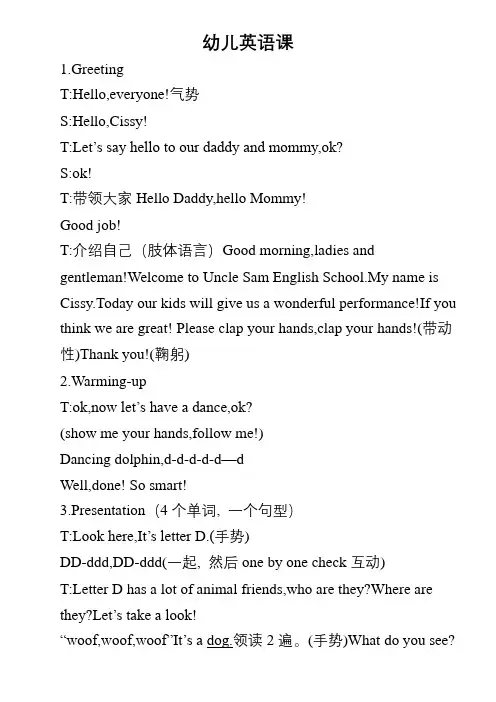
幼儿英语课1.GreetingT:Hello,everyone!气势S:Hello,Cissy!T:Let’s say hello to our daddy and mommy,ok?S:ok!T:带领大家Hello Daddy,hello Mommy!Good job!T:介绍自己(肢体语言)Good morning,ladies and gentleman!Welcome to Uncle Sam English School.My name is Cissy.Today our kids will give us a wonderful performance!If you think we are great! Please clap your hands,clap your hands!(带动性)Thank you!(鞠躬)2.Warming-upT:ok,now let’s have a dance,ok?(show me your hands,follow me!)Dancing dolphin,d-d-d-d-d—dWell,done! So smart!3.Presentation(4个单词, 一个句型)T:Look here,It’s letter D.(手势)DD-ddd,DD-ddd(一起, 然后one by one check互动)T:Letter D has a lot of animal friends,who are they?Where are they?Let’s take a look!“woof,woof,woof”It’s a dog.领读2遍。
(手势)What do you see?.se..dog..se..dog.Nex.friend, wher.ar.you?Ohh,it’.a__. What do you see ?I see the duck.Nex.friend,what’.tha.?It’..__.领读2遍。
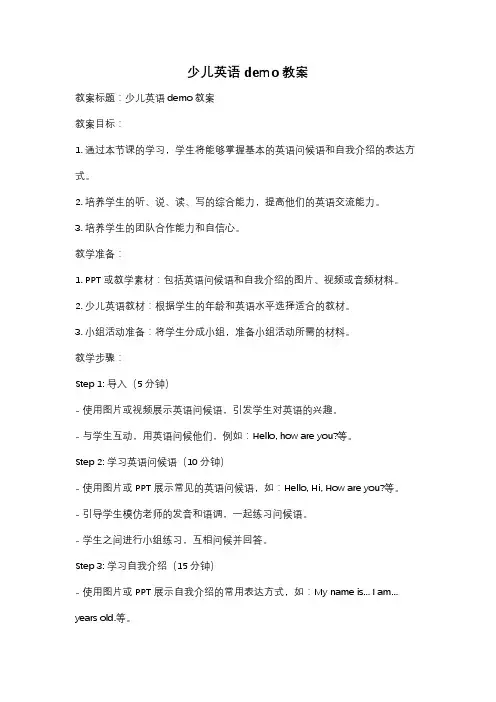
少儿英语demo教案教案标题:少儿英语demo教案教案目标:1. 通过本节课的学习,学生将能够掌握基本的英语问候语和自我介绍的表达方式。
2. 培养学生的听、说、读、写的综合能力,提高他们的英语交流能力。
3. 培养学生的团队合作能力和自信心。
教学准备:1. PPT或教学素材:包括英语问候语和自我介绍的图片、视频或音频材料。
2. 少儿英语教材:根据学生的年龄和英语水平选择适合的教材。
3. 小组活动准备:将学生分成小组,准备小组活动所需的材料。
教学步骤:Step 1: 导入(5分钟)- 使用图片或视频展示英语问候语,引发学生对英语的兴趣。
- 与学生互动,用英语问候他们,例如:Hello, how are you?等。
Step 2: 学习英语问候语(10分钟)- 使用图片或PPT展示常见的英语问候语,如:Hello, Hi, How are you?等。
- 引导学生模仿老师的发音和语调,一起练习问候语。
- 学生之间进行小组练习,互相问候并回答。
Step 3: 学习自我介绍(15分钟)- 使用图片或PPT展示自我介绍的常用表达方式,如:My name is... I am... years old.等。
- 引导学生模仿老师的发音和语调,一起练习自我介绍。
- 学生之间进行小组练习,互相进行自我介绍。
Step 4: 综合运用(15分钟)- 将学生分成小组,每个小组选择一位代表进行自我介绍。
- 其他小组成员可以提问代表,例如:How old are you? What is your favorite color?等。
- 鼓励学生用英语回答问题,并互相交流。
Step 5: 小结和延伸(5分钟)- 复习本节课所学的英语问候语和自我介绍的表达方式。
- 鼓励学生在日常生活中多使用英语进行问候和自我介绍。
- 提供一些相关的练习题或作业,巩固学生的学习成果。
Step 6: 结束(5分钟)- 总结本节课的重点内容和学习收获。


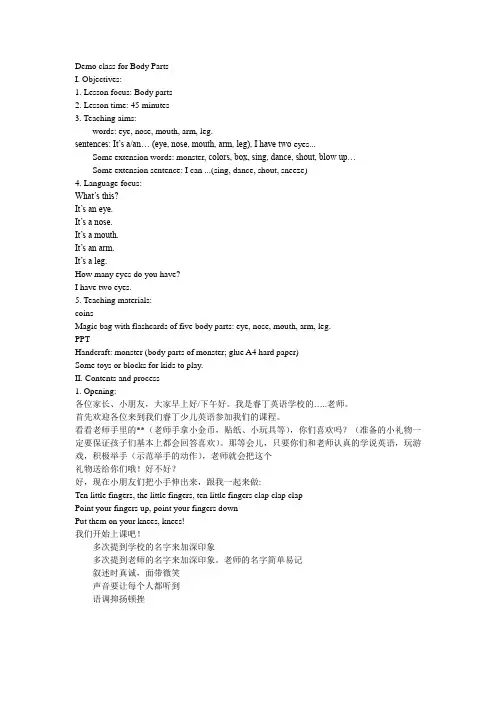
少儿英语示范课demo课Title: Jungle AdventureObjective: To introduce and develop basic English vocabulary related to animals and their characteristics.Level: Beginner (4-6 years old)Materials:- Picture cards of jungle animals (lion, monkey, elephant, giraffe, etc.)- Flashcards of adjectives (big, small, strong, fast, etc.)- Large poster of a jungle scene- Small toy animalsIntroduction (5 minutes):1. Greet the children and introduce yourself.2. Show the picture cards of jungle animals and ask the children if they know any of them.3. Name each animal and elicit the sounds they make. Encourage the children to imitate the sounds together.Warm-up activity (10 minutes):1. Have the children sit in a circle.2. Using the small toy animals, pass one animal to each child.3. Play a song about jungle animals and have the children pass the animals around the circle while the music plays.4. When the music stops, the child holding the animal should stand up and make the sound of the animal.5. Repeat the game with different animals and sounds.Main activity: Animal characteristics (15 minutes):1. Display the large jungle scene poster.2. Show the picture cards of animals one by one and ask the children to name them.3. Choose one animal and ask the children to describe its characteristics using the adjectives on the flashcards.4. Place the flashcards on the poster next to the corresponding animal.5. Repeat the activity with different animals, encouraging the children to come up with their own descriptions.Interactive game: Animal guess (10 minutes):1. Divide the children into pairs or small groups.2. Give each group a set of animal picture cards.3. One child picks a card without showing it to the others and gives clues about the animal's characteristics.4. The other children try to guess the animal.5. Rotate turns until all the cards have been used.Conclusion: Storytime with animals (5 minutes):1. Gather the children in a circle.2. Read a short story or picture book about jungle animals, using props or hand puppets if available.3. Ask the children questions about the story to check their comprehension.4. Recap the different animal characteristics learned during the class.Note: This demo lesson is just a sample suggestion and can bemodified based on the needs and preferences of the teacher and students. The activities can be adapted or extended as desired.。
少儿英语示范课demo课教案一、教学目标本节课旨在通过示范课的形式,向学生们展示少儿英语学习的基本方法和技巧,帮助他们提高英语听说能力,增强对英语学习的兴趣和自信心。
同时,通过与老师的互动和合作,培养学生的团队合作精神和沟通能力。
二、教学内容本节课将通过歌曲、故事、游戏等多种形式,让学生们学习英语单词、短语和简单的句子,同时锻炼他们的听力和口语能力。
具体内容包括:学习英文歌曲《ABC Song》,熟悉英文字母的发音和拼写规则。
通过故事《The Cat and the Mouse》学习常见动物名称和简单的动词短语。
运用游戏《Hide and Seek》练习所学单词和短语,增强记忆效果。
三、教学重点与难点重点:通过示范课,让学生掌握正确的英语发音和拼写方法,熟悉基本的听说技巧。
难点:如何运用游戏等教学方法,让学生在轻松愉悦的氛围中掌握所学内容。
四、教具和多媒体资源本节课将使用以下教具和多媒体资源:电脑与投影机:播放教学PPT和视频。
黑板:列举重点词汇和短语。
教学卡片:展示动物图片和英文单词。
玩具:用于模拟游戏活动。
五、教学方法本节课将运用以下教学方法:激活学生的前知:通过提问了解学生前期所学的英语知识。
教学策略:采用讲解、示范、小组讨论和游戏等方法。
学生活动:组织学生进行歌曲演唱、故事讲述、游戏互动等。
六、教学过程导入:通过播放英文歌曲《ABC Song》,引导学生进入英语学习氛围。
讲授新课:通过PPT展示英文字母的发音规则和拼写方法,带领学生朗读单词和短语。
巩固练习:让学生分组进行角色扮演,讲述故事《The Cat and the Mouse》,并运用所学单词和短语进行简单的对话。
归纳小结:通过游戏《Hide and Seek》回顾所学内容,加深学生对单词和短语的记忆。
七、评价与反馈设计评价策略:组织学生进行小组讨论,分享学习心得,并鼓励他们提出问题和建议。
为学生提供反馈:根据学生在课堂上的表现,给予及时反馈和指导,帮助他们改进学习方法。